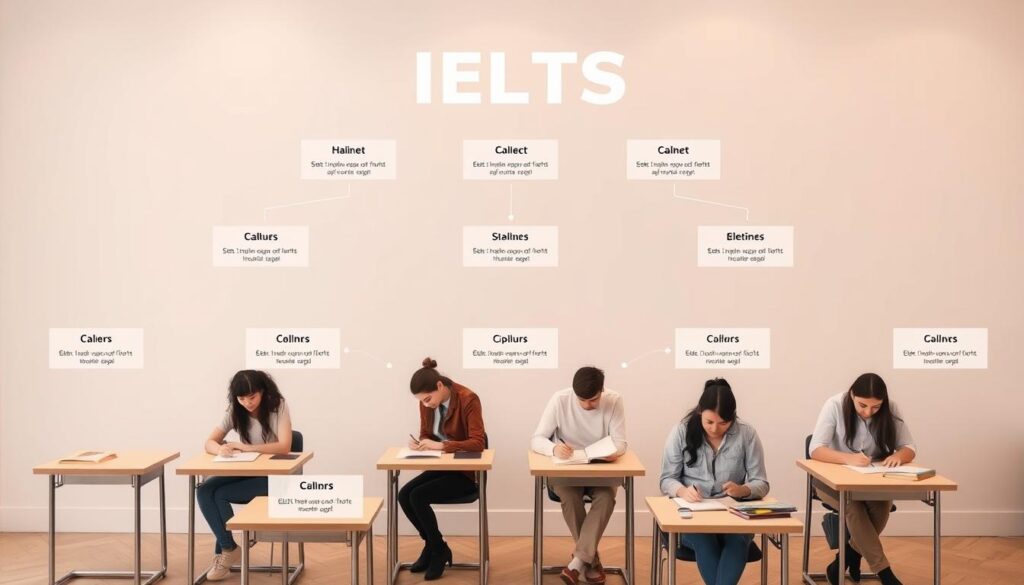Are you wondering how to help your child excel in their academic writing test? Preparing for such tasks can feel overwhelming, but with the right resources, it becomes manageable and even rewarding. We understand the challenges students face, and that’s why we’ve created a comprehensive collection of materials designed to guide them every step of the way.
Our expertly curated resources provide clear insights into every aspect of the test. From detailed sample tasks to model answers, we ensure your child is well-prepared for any question they might encounter. Whether it’s the listening, reading, writing, or speaking component, our materials cover it all.
We take pride in offering accurate representations of both computer-based and paper-based formats. Our step-by-step guides help students navigate varied question types, ensuring focused and effective preparation. With our proven approach, your child can build confidence and improve their overall test competence.
Key Takeaways
- Curated resources provide clear insights into every aspect of the test.
- Detailed sample tasks and model answers enhance preparation.
- Covers all components: listening, reading, writing, and speaking.
- Accurate representations of computer-based and paper-based formats.
- Step-by-step guides help navigate varied question types.
- Builds confidence and improves overall test competence.
Understanding the IELTS Test Format
Understanding the structure of the test is crucial for effective preparation. The exam is divided into four main components: Listening, Reading, Writing, and Speaking. Each part has its unique challenges and requirements, which we’ll break down for you.
Overview of Listening, Reading, Writing, and Speaking
The Listening section lasts about 30 minutes and includes 40 questions. These are divided into four parts, with tasks like multiple choice, matching, and diagram labeling. Familiarizing yourself with these formats can help you stay focused during the test.
In the Reading section, you’ll have 60 minutes to answer 40 questions. The texts are designed to test your comprehension and analytical skills. Academic versions include complex texts, while General Training uses everyday materials.
The Writing section also takes 60 minutes and consists of two tasks. Task 1 requires you to describe visual data, while Task 2 involves writing an essay. Proper time management is key here.
Finally, the Speaking section is a face-to-face interview lasting 11–14 minutes. It’s divided into three parts: an introduction, a short speech, and a discussion. Practicing with sample questions can boost your confidence.

Differences Between Academic and General Training
The Academic and General Training versions differ mainly in the Reading and Writing sections. Academic Reading includes complex texts, while General Training uses everyday materials like advertisements and notices.
In the Writing section, Academic Task 1 involves describing graphs or charts, whereas General Training requires writing a letter. Understanding these differences ensures you prepare effectively for your specific test.
| Section | Duration | Tasks |
|---|---|---|
| Listening | 30 minutes | 40 questions (multiple choice, matching, etc.) |
| Reading | 60 minutes | 40 questions (text comprehension) |
| Writing | 60 minutes | 2 tasks (data description, essay) |
| Speaking | 11–14 minutes | 3 parts (introduction, speech, discussion) |
Mastering the test format is a vital step toward achieving a high score. With clear insights into each section, you can approach your preparation with confidence and focus.
Effective Strategies to Boost Your IELTS Score
Scoring high on the test requires more than just knowledge; it demands strategy. With the right approach, you can tackle each section confidently and efficiently. Here, we’ll share expert tips and highlight common mistakes to avoid, ensuring you’re fully prepared.

Expert Tips for Every Test Section
For the Listening section, practice with diverse audio materials like podcasts and news programs. This helps you adapt to different accents and speeds. Focus on understanding the main ideas and specific details.
In the Reading section, develop a habit of reading extracts carefully. Skim for the main idea first, then scan for specific information. This saves time and improves accuracy.
For the Writing task, plan your response before you start. Allocate time wisely: 20 minutes for Task 1 and 40 minutes for Task 2. Compare your drafts with model answers to identify areas for improvement.
In the Speaking section, practice speaking on various topics daily. Record yourself to evaluate fluency and pronunciation. Aim for clarity and coherence in your responses.
Avoiding Common Pitfalls
One common mistake is poor time management. Always practice under timed conditions to simulate the real test. Another pitfall is not reading instructions carefully, which can lead to lost marks.
For the academic reading test, avoid spending too much time on a single question. Move on and return to it later if needed. In the writing task, ensure your essay has a clear structure with an introduction, body, and conclusion.
| Section | Strategy | Common Pitfall |
|---|---|---|
| Listening | Practice with diverse audio materials | Misunderstanding instructions |
| Reading | Skim and scan for key information | Spending too much time on one question |
| Writing | Plan and compare with model answers | Lack of essay structure |
| Speaking | Practice daily and record yourself | Incoherent responses |
By applying these strategies and avoiding common mistakes, you can significantly improve your performance. Consistent practice and a focused approach will help you achieve your desired score.
Mastering IELTS Past Paper Practice
To excel in the test, students need to practice with the right resources and techniques. Our materials are designed to provide a clear roadmap for success, ensuring every student can confidently tackle the challenges ahead.

Utilizing Proven Resources Effectively
Our resources include detailed sample tasks and model answers that help students understand what is expected. By practicing with these materials, students can identify their strengths and areas for improvement.
For the reading test, our academic and general training samples cover a wide range of topics. This ensures students are prepared for any question they might encounter. Similarly, our writing tasks provide clear guidelines for structuring responses effectively.
Step-by-Step Guide to Practice Sessions
Follow this structured approach to make the most of your practice sessions:
- Set a Schedule: Dedicate specific times daily for practice to build consistency.
- Use Sample Tasks: Work through our curated tasks to familiarize yourself with the test format.
- Review Model Answers: Compare your responses to identify gaps and refine your approach.
- Simulate Test Conditions: Practice under timed conditions to improve time management.
- Seek Feedback: Share your answers with a mentor or peer for constructive feedback.
Timely review and feedback are crucial for improvement. By analyzing your performance regularly, you can track progress and adjust your strategies as needed.
| Step | Action | Benefit |
|---|---|---|
| 1 | Set a Schedule | Builds consistency and discipline |
| 2 | Use Sample Tasks | Familiarizes with test format |
| 3 | Review Model Answers | Identifies areas for improvement |
| 4 | Simulate Test Conditions | Improves time management |
| 5 | Seek Feedback | Provides actionable insights |
Our guide empowers students to self-assess and optimize their preparation. By following these steps, you can approach the test with confidence and achieve your desired score.
Navigating Academic and General Training Sections
Choosing the right test format can significantly impact your preparation and performance. Whether you’re aiming for Academic or General Training, understanding the differences is key to success. We’ll guide you through the unique aspects of each format, helping you tailor your study plan effectively.

In-Depth Look at Academic Writing and Reading
The Academic format is designed for those pursuing higher education or professional registration. In the Writing section, Task 1 requires you to describe visual data like graphs, charts, or diagrams. Task 2 involves writing an essay in response to a point of view or argument.
For the Reading section, you’ll encounter complex texts from journals, books, and reports. These are designed to test your ability to understand and analyze academic content. Practice with diverse materials to improve your comprehension and speed.
Understanding General Training Test Formats
The General Training format is ideal for those migrating to an English-speaking country or seeking work experience. In the Writing section, Task 1 involves writing a letter, while Task 2 requires an essay response to a point of view. The tone is more personal and practical.
For the Reading section, texts are drawn from everyday materials like advertisements, notices, and workplace documents. This format assesses your ability to understand and use English in daily life.
| Section | Academic Format | General Training Format |
|---|---|---|
| Writing Task 1 | Describe visual data (graphs, charts) | Write a letter |
| Writing Task 2 | Essay response to a point of view | Essay response to a point of view |
| Reading | Complex academic texts | Everyday materials |
Understanding these differences ensures you prepare effectively for your specific test. Our resources are tailored to meet the unique challenges of both formats, providing you with the tools you need to succeed. For more tips on effective preparation, check out our comprehensive guide.
Timed Practice Tests: Skills and Techniques
Timed practice tests are a game-changer for mastering exam skills. They simulate real test conditions, helping you build confidence and efficiency. By practicing under strict time limits, you can refine your strategies and reduce exam stress.

Benefits of Simulated Test Conditions
Simulated tests mirror the actual exam environment. This includes strict adherence to time limits and question formats. Practicing this way helps you develop efficient test-taking strategies and manage time effectively.
For example, in the writing task, you’ll have 60 minutes to complete two tasks. Timed practice ensures you allocate time wisely: 20 minutes for Task 1 and 40 minutes for Task 2. This approach improves your ability to answer questions accurately and quickly.
Reviewing and Comparing Model Answers
After completing a practice test, review your performance. Compare your answers with model answer keys to identify gaps. This process helps you understand what is expected and refine your approach.
For instance, if you’re asked to write an essay, analyze the structure and clarity of model responses. Look for ways to improve your essay response point and ensure your arguments are well-supported.
Consistent timed practice sharpens both writing and reading responses. It also prepares you for the pressure of the actual exam. Our structured practice tests cover all segments, ensuring balanced preparation.
Conclusion
Achieving success in your test preparation journey is within reach with the right tools and strategies. Our resources provide comprehensive coverage of all test formats, ensuring you’re well-prepared for every section. From detailed extracts to structured practice sessions, we guide you every step of the way.
Mastering timed practice tests is essential for building confidence and improving performance. By simulating real test conditions, you can refine your skills and manage time effectively. Our three-part approach—practice, review, and feedback—ensures continuous improvement.
We are committed to delivering high-quality educational support tailored to your needs. Whether you’re preparing for the test academic or general training, our expert resources and actionable strategies will help you excel. Start your journey today with our free online practice tests and experience the difference.
FAQ
What is the IELTS test format?
The IELTS test consists of four sections: Listening, Reading, Writing, and Speaking. Each section assesses different language skills, with Academic and General Training versions tailored to specific needs.
How can I improve my IELTS score effectively?
Focus on expert strategies for each section, avoid common mistakes, and practice regularly using proven resources like past papers and timed tests to simulate real exam conditions.
What are the key differences between Academic and General Training?
Academic IELTS is designed for university admissions, emphasizing complex texts and formal writing. General Training is for work or migration, focusing on everyday language and practical tasks.
How do I use past papers to prepare for the IELTS?
Start by familiarizing yourself with the test structure. Practice under timed conditions, review model answers, and identify areas for improvement to enhance your performance.
What are the benefits of timed practice tests?
Timed tests help you manage time effectively, build confidence, and adapt to the pressure of real exam conditions, ensuring you’re fully prepared on test day.
How can I master the Academic Writing and Reading sections?
Focus on understanding complex texts, developing strong arguments, and practicing structured essays. Use past papers to refine your skills and improve accuracy.
What should I expect in the General Training test?
The General Training test includes tasks like writing letters and interpreting everyday texts. It’s designed to assess your ability to communicate in practical, real-life situations.


